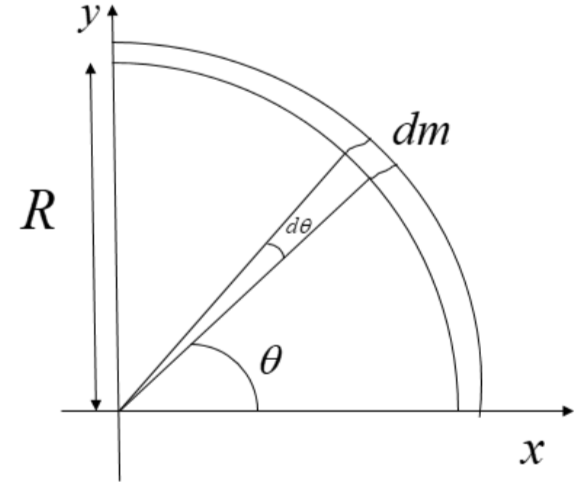Question
Question: Find coordinates of the center of mass of a quarter ring of radius placed in the first quadrant of a...
Find coordinates of the center of mass of a quarter ring of radius placed in the first quadrant of a Cartesian coordinate system, with center at the origin.
Solution
Quarter ring indicates that we need to find the center of mass for one-fourth of the ring placed in the first quadrant. We will find the general expression of coordinates of a small part of the ring. Finally, we will integrate it to find the required coordinates using the basic formula.
Formula Used:
XCM=M1∫xdm
YCM=M1∫ydm
Complete step-by-step solution:
Here, we need to find the coordinates of the centre of mass of one fourth of a ring placed in the first quadrant. We will assume the origin as the centre of the circle, of which the ring is a part of, and then we can draw the diagram as follows:

Here, consider a one fourth ring present in the first quadrant having a total mass M and radius R and subtending a total angle of 2π at the origin.
To find the centre of mass, consider a small portion of the ring at an angle θ from the x-axis. Let the mass of this portion be dm of length l and the angle subtended by this portion at the origin be dθ.
Here, we will find the x as well as y component of the centre of mass and hence the coordinates of centre of mass.
Here, the total mass M subtends an angle of 2π. Also, the mass dm subtends an angle of dθ
Hence, the mass dmcan be written as:
dm=(π/2)M×dθ ----(i)
Also, the length of the mass dm can be written as:
dθ=Rl
⇒l=Rdθ ----(ii)
Also, at any angle θ the general x coordinate and y coordinate can be written as:
x=Rcosθ
y=Rsinθ
For x coordinate:
XCM=M1∫xdm
⇒XCM=M1∫Rcosθdm
From equation (i)
⇒XCM=M1∫Rcosθ(π/2)M×dθ
⇒XCM=π2R0∫π/2cosθdθ
⇒XCM=π2R
For y coordinate:
YCM=M1∫ydm
⇒YCM=M1∫Rsinθdm
From equation (i)
YCM=M1∫Rsinθ(π/2)Mdθ
⇒YCM=π2R0∫π/2sinθdθ
⇒YCM=π2R
Hence, the coordinates of the centre of mass of a quarter ring placed in the first quadrant is (XCM,YCM)=(π2R,π2R).
Note: To find centre of mass, always take a small mass into consideration. Find out the general equation for the x and y coordinate for that small part. Then use the basic formula to find the coordinates of the centre of mass.
